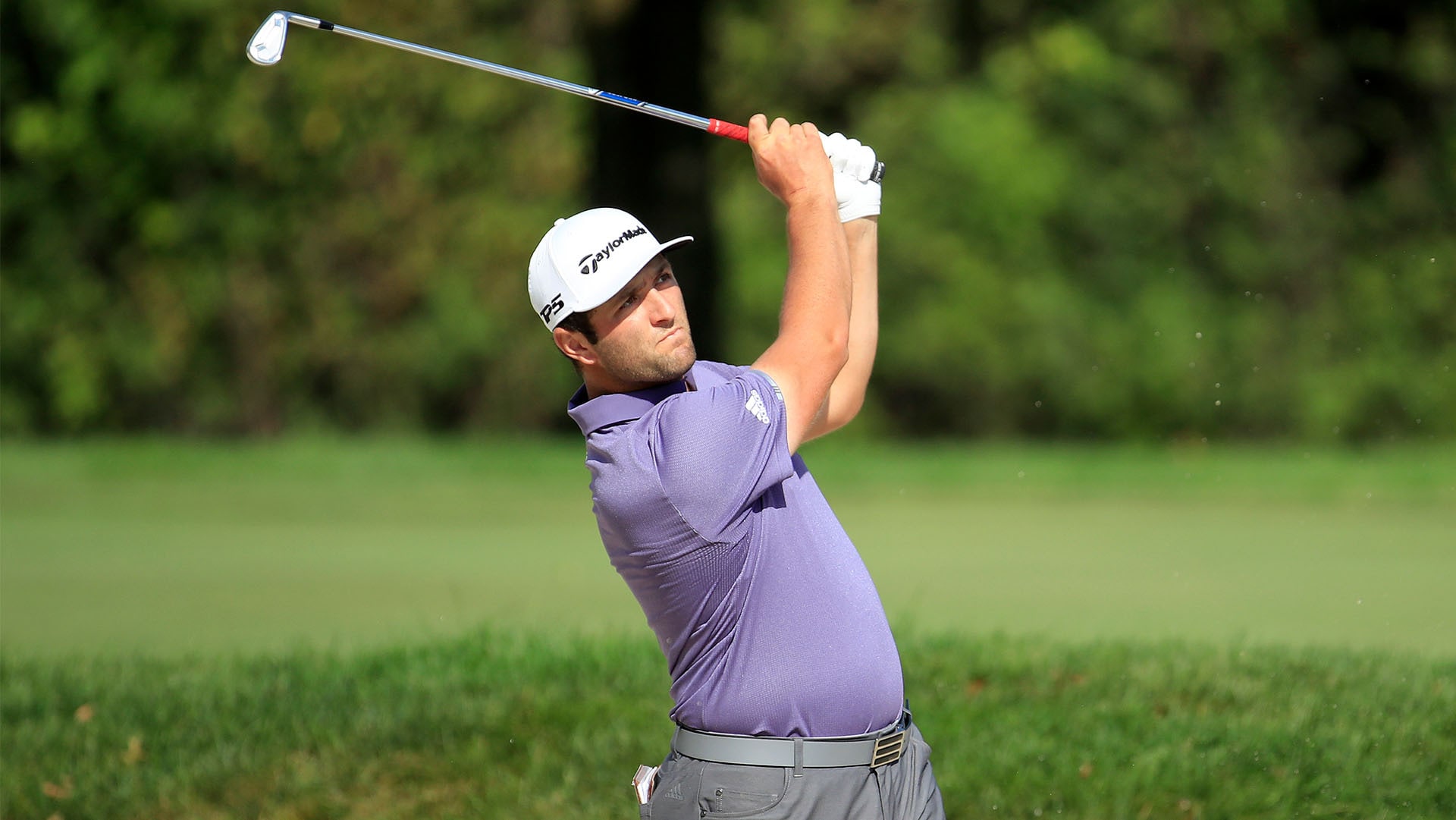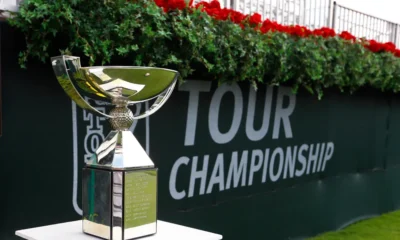First on the Tee
First On The Tee: Don’t Give Short Shrift to the Long Bombers

There’s been an ongoing debate in golf about distance.
Bryson DeChambeau’s eye-catching transformation over the past year has accelerated the arguments about if length has become too important in the sport, but this is just the latest development over what some would have you believe is a battle for the soul of golf.
To be fair, much of the traditionalist case centers on how classic courses could become obsolete due to golf’s power surge. Or, the conservative thinkers lament how many old standards have already been mothballed or drastically altered to keep up with the sport’s elite.
But I also feel there’s a significant snob factor going on here. An anti-bomber bias, if you will.
You see, there’s no burgeoning backlash against the increasing number putts falling in high-level golf. No complaints about players hitting more greens and stopping the ball closer to the hole, either.
In both of those cases, there’s little doubt technology and training have converged to produce more efficient golfers, especially on the PGA Tour. The same is the case with players hitting ball farther than ever before, yet that particular development has been deemed somehow more questionable and objectionable than the others.
To which I ask: Why?
Just like short-game prowess or approach control, swinging for power is a skill. I suspect that because physical strength is a large factor in propelling the golf ball longer distances, for some people it’s somehow a more pedestrian accomplishment to add 10 yards to one’s drive than it is to hit one’s irons five feet closer.
It’s not. In fact, I’d argue that the smartest thing a golfer can do is try to add distance to every shot he or she hits.
And I’m not just saying that because the Mad Scientist, Mr. DeChambeau, successfully pulled off his intended move to the top of the driving-distance charts and has been a top-10 machine this season. Numerous studies have shown that, independent of lie or angle to the flag, simply getting one’s ball closer to the hole almost universally improves scores across the board — from the lowliest hacker to the most polished pro.
While better equipment and, particularly at the higher levels, better fitness have pushed the envelope on how far the ball can go, that doesn’t mean that we should turn our noses up at the players who master dialing long distance better than their peers. (That line played better in the 1990s.)
I think that results like what we just saw at the BMW Championship, where narrow fairways at Olympia Fields led to more misses than usual, spook some people. Epitomized by the Jon Rahm-Dustin Johnson tie for first, the leaderboard was dominated by the longest hitters on tour.
Field average so far is under 50%. If everyone’s gonna miss fairways, it’s good to be way down there. https://t.co/klokDWNFUj
— No Laying Up (@NoLayingUp) August 29, 2020
The conventional wisdom has always held that tight tee shots keep the long hitters from running the show. The reality is almost the opposite. Yes, accuracy matters, but if you miss into deep rough, you’re much better off coming at the green from 125 yards than 175.
That’s not to say that a shorter hitter can’t compete and win. Just like a mediocre putter or an average iron player can compete and win, as long as he or she can compensate in other aspects of the game.
So, when we have the debate about whether too much distance is corrupting golf, let’s separate the argument about the sustainability of the sport from the fact that hitting it long has been and will always be an advantage. As it should be.
Not like you can’t, you know, just get stronger if you’re getting the ball blown past you. We’ve seen players as old as newly-crowned Champions Tour winner Phil Mickelson add significant distance in recent years. For most players, getting longer is just as feasible as sharpening one’s putting or iron play, albeit maybe slightly less elegant.
And as the results show, muscling up is probably the most efficient way to improve. Maybe the bombers should be the ones turning up their noses at the smooth putters or the flag-hunting artists.
Maybe distance is the purest fundamental.
DOWN THE FAIRWAY
• Not to bury the lead, but … if you liked those dueling bombs from Justin Thomas-Collin Morikawa last month in Columbus, you loved what Johnson and Rahm provided in the PGA Tour’s second FedEx Cup playoff event.
66 FEET for the WIN! 🏆
UNBELIEVABLE putt from @JonRahmPGA to claim @BMWChamps in a playoff! #QuickHits pic.twitter.com/DktJRjZLoj
— PGA TOUR (@PGATOUR) August 30, 2020
I’m still not sure which putt was more impressive on its face, that winning 66-foot slider from Rahm, or the do-or-die tickler that Johnson knocked down on the final hole of regulation.
A perfect putt at the perfect time.
If he misses, he loses.
RIDICULOUS, @DJohnsonPGA. 😲#QuickHits pic.twitter.com/RD638C3Hdf
— PGA TOUR (@PGATOUR) August 30, 2020
I guess I tend to lean toward the must-have clutch moments in sport, but Rahm’s sudden victory was the icing on the cake of an unexpectedly fun weekend in Chicagoland.
I’ll admit I didn’t quite appreciate how tough Olympia Fields would play entering the BMW Championship. My only previous viewing experience there was when Jim Furyk blew away the U.S. Open field in 2003, but even though Furyk set the tournament scoring record with 272 strokes, he was one of just four players under par that week.
Just five men were below par over the weekend, making it a near-major feel — and a perfect “ramp up” for the U.S. Open next month at Winged Foot, as none other that Tiger Woods put it Sunday.
I know the PGA Tour doesn’t like to repeat locations for its non-Tour Championship playoff events, but I’d love to see Olympia Fields get on a semi-regular rotation at least. Especially after the Northern Trust birdie fest at TPC Boston, the BMW was a welcomed palate-cleanser.
• Rahm’s victory aside, it’s difficult to pick anyone other than DJ to prevail at East Lake Golf Club in this weekend’s Tour Championship.
One week after powering to an 11-stroke victory at an incredible 30 under par in Boston, Johnson was inches away from grinding out a win at a place where 4 under got you into a playoff. That’s the versatile, transportable game that validates his current No. 1 ranking in the world.
With a two-shot head start on the field starting Friday afternoon, the big thoroughbred is going to be challenging to chase down, but the fact that we have the World No. 2 (Rahm) and No. 3 (Justin Thomas) lining up just behind him makes me think we’re in for another viewing treat.
• Speaking of treats, it was a privilege and a pleasure to walk the front nine with the final pairing of the Western Pennsylvania Golf Association’s Amateur Championship last Tuesday at Allegheny Country Club.
Here’s my on-site coverage if you missed it, as Peters Township alum and Drexel University star senior Connor Schmidt successfully defended his title by a couple of strokes, holding off upward-trending contenders like Darin Kowalski and Jimmy Ellis in the process.
I haven’t gotten out of the house to cover as many live events this summer as I’d like — a new baby will do that, it turns out — but witnessing Schmidt’s six-birdies-in-seven-holes start was one moment on the local amateur scene I’m glad I didn’t miss.
• Here’s one thing I did miss, due to our family’s COVID vacation to Michigan last week: Allegheny CC’s John Aber was your champion of the Tri-State PGA’s Section Championship, held at The Pines Country Club in Morgantown, W.Va.
Aber crushed the field on the second day of play, shooting a 7-under 64 to sprint past runner-up Matt Tashenberg by three strokes. Aber had been tied for eighth after a first-round 72, but he had plenty in the tank to earn his second win of 2020.
Congratulations to John Aber on his victory in this year’s TSPGA Section Championship!
National Qualifiers:
1. John Aber
2. Matt Tashenberg
3. Brett Carman
4. Rob McClellan*
5. Jason Robinson** Won Playoff
Great playing to all and thank you to The Pines CC & our partners! pic.twitter.com/yOQL4wn2fV
— Tri-State PGA (@TriStatePGA) August 25, 2020
Along with him, Pikewood National Golf Club’s Tashenberg, Brett Carman (Valley Brook CC), Rob McClellan (Slippery Rock GC) and Jason Robinson (Wheeling CC) all qualified to represent the section at the 2021 National PGA Professional Championship.
• News from the WPGA as well, as the area’s amateur governing body has ruled that the field for its Mid-Amateur Championship will be limited to 42 players due to continuing COVID-19 precautions.
The top 10 finishers from the past three Mid-Ams will qualify if they choose to play, as will the qualifiers from the past four West Penn Amateur and Open Championships, plus any competitors from USGA events over the past three years.
The 35th edition of the WPGA’s Mid-Am will take place Tuesday, Sept. 8 at Longue Vue Club in Verona. After initially being reduced to 18 holes because of pandemic concerns, the event has been extended back to its usual 36-hole length.
• Hope you got to check out our latest Course Review from Ligonier Country Club! I was on location again last week to detail a very different kind of golf experience, but one that was just as fun. Coming soon …













